What is cloud cost allocation?
Cloud cost allocation covers a set of processes which assign cloud expenses to relevant stakeholders for accountability and budget management.
Advantages:
- Cloud Cost Transparency: Provides visibility into how cloud costs are distributed across different teams or projects.
- Cost Accountability: Holds stakeholders accountable for their cloud resource usage in order to promote cost-conscious behavior.
- Budget Control: Enables better budget management by accurately attributing costs to departments or projects.
Challenges:
- Complexity: Managing cost allocation in dynamic cloud environments with diverse usage patterns can be complex.
- Granularity: Accurate tracking and categorization of cloud expenses to anchieve granularity in cost allocation requires .
- Tooling Requirements: Effective cost allocation relies on robust tools and processes for tracking and attributing costs accurately.
What is cloud cost tagging?
Tagging involves attaching metadata to cloud resources, such as instances, storage, or databases, to categorize and organize them based on attributes like department, project, or environment.
Examples of How to Use Tags to Allocate Cloud Costs and Resources:
- Departmental Cost Allocation: Tag cloud resources with department names in order to allocate costs based on usage, which will enable each department to track and manage its cloud spending.
- Project-Based Allocation: Tag resources with project IDs or names for attributing costs to specific projects, facilitating budget management and resource optimization for each project.
How to Manage Cost Allocation:
- Tagging Strategy: Develop a comprehensive tagging strategy to categorize resources accurately and align with cost allocation requirements.
- Automated Tagging: Implement automated tagging mechanisms to ensure consistency and accuracy in resource tagging, reducing manual effort and errors.
- Regular Review: Conduct regular reviews of cost allocation data and processes to identify inefficiencies, optimize resource usage, and ensure alignment with organizational objectives.
- Visualization and Reporting Tools: Implement visualization and reporting tools to provide stakeholders and different departments with clear insights into their cloud spending and resource usage. Develop customizable dashboards that display key metrics, cost breakdowns, and usage trends in an easily understandable format. This enables stakeholders to track their spending in real-time, identify areas for optimization, and make informed decisions about resource allocation. Additionally, provide access to detailed reports and analysis tools that allow stakeholders to drill down into specific cost data and investigate anomalies or discrepancies. By fostering transparency and accountability through accessible cost data, organizations can encourage responsible resource usage and facilitate collaboration across departments.
By implementing effective tagging strategies and automated processes, organizations can streamline cloud cost allocation, promote accountability, and optimize resource usage, ultimately maximizing the value derived from cloud investments.




